Heinrich J.G., Aldinger F. (Eds.) Ceramic Materials and Components for Engines
Подождите немного. Документ загружается.

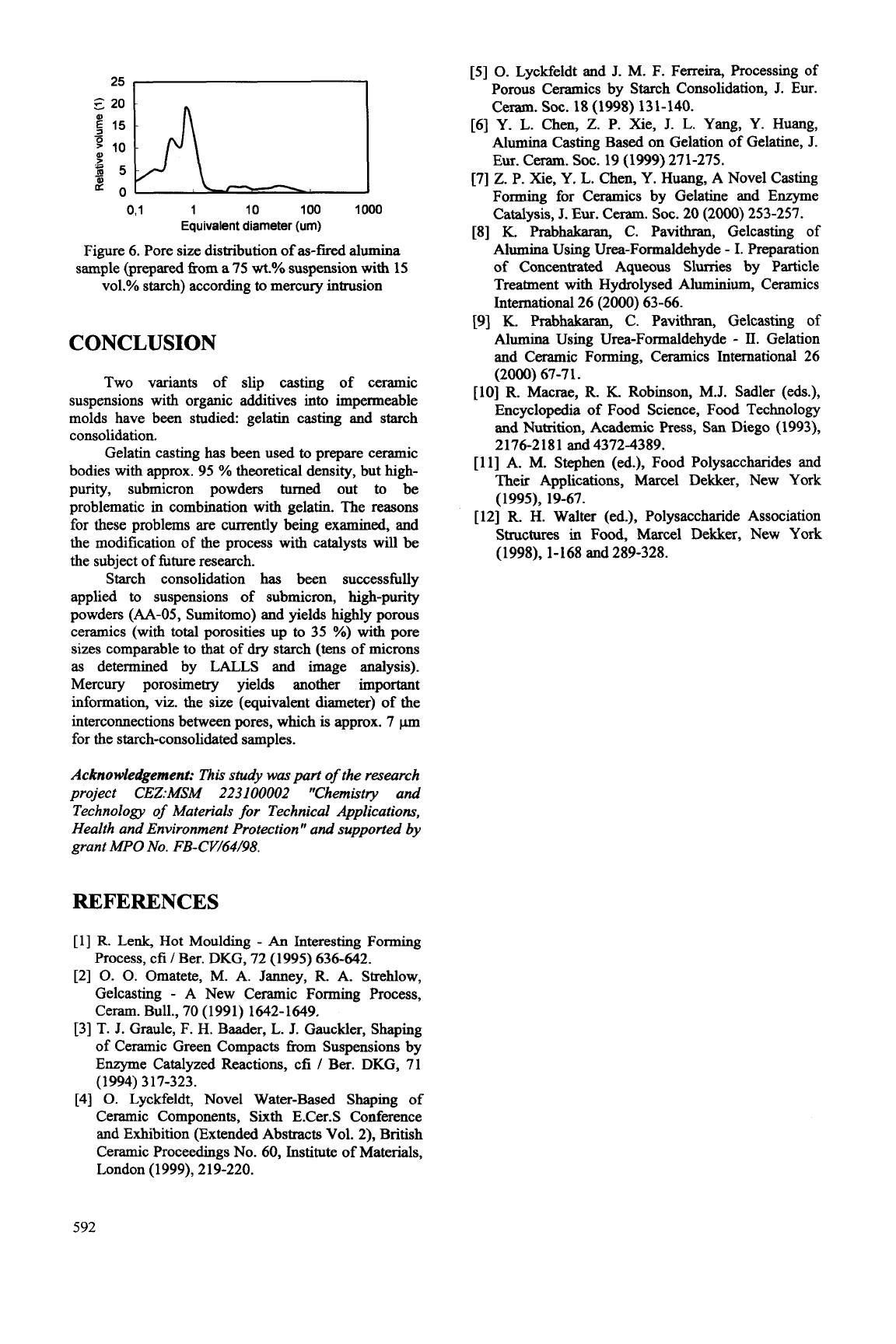
25
n
I
0.1
1
10
100
1000
Equivalent diameter (um)
Figure 6. Pore size distribution of as-fired alumina
sample (prepared fiom a 75
wt.%
suspension with 15
vol.% starch) according
to
mercury intrusion
CONCLUSION
Two variants of slip casting of ceramic
suspensions with organic additives into impermeable
molds have been studied gelatin casting and starch
consolidation.
Gelatin casting has been used
to
prepare ceramic
bodies with approx. 95
%
theoretical density, but high-
purity, submicron powders turned out
to
be
problematic
in
combination with gelatin. The reasons
for these problems are currently being examined, and
the modification
of
the process with catalysts
will
be
the subject of fbture research.
Starch consolidation has been successhlly
applied
to
suspensions
of
submicron, high-purity
powders
(a-05,
Sumitomo) and yields highly porous
ceramics (with total porosities up
to
35
'YO)
with pore
sizes comparable
to
that
of
dry
starch
(tens
of
microns
as determined by LALLS and image analysis).
Mercury porosimetry yields another important
information, viz. the size (equivalent diameter)
of
the
interconnections between pores, which
is
approx. 7
pm
for the starch-consolidated samples.
Acknowledgement: This study
was
part
of
the research
project CEZ:MSM
2231
00002
"Chemistry and
Technology
of
Materials for Technical Applications,
Health and Environment Protection" and supported
by
grant MPO
No.
FB-CV/64/98.
REFERENCES
[l]
R.
Lenk,
Hot
Moulding
-
An
Interesting Forming
Process, cfi
/
Ber. DKG, 72 (1995) 636-642.
[2]
0.
0.
Omatete, M. A. Janney, R. A. Strehlow,
Gelcasting
-
A New Ceramic Forming Process,
Ceram. Bull., 70 (1991) 1642-1649,
[3] T. J. Grade,
F.
H.
Baader, L. J. Gauckler, Shaping
of Ceramic Green Compacts fiom Suspensions by
Enzyme Catalyzed Reactions, cfi
/
Ber. DKG, 71
[4]
0.
Lyckfeldt, Novel Water-Based Shaping of
Ceramic Components, Sixth E.Cer.S Conference
and Exhibition (Extended Abstracts Vol. 2), British
Ceramic Proceedings No. 60, Institute of Materials,
London (1 999), 2 19-220.
(1994) 317-323.
[5]
0.
Lyckfeldt and J. M. F. Ferreira, Processing of
Porous Ceramics by Starch Consolidation, J. Eur.
Ceram.
SOC.
18 (1998) 131-140.
[6] Y. L. Chen,
Z.
P. Xie, J. L. Yang, Y. Huang,
Alumina Casting
Based
on
Gelation of Gelatine, J.
[7]
Z.
P. Xie,
Y.
L. Chen,
Y.
Huang, A Novel Casting
Forming for Ceramics by Gelatine and Enzyme
Catalysis, J.
Eur.
Ceram. SOC. 20 (2000) 253-257.
[8]
K.
Prabhakaran, C. Pavithran, Gelcasting
of
Alumina Using Urea-Formaldehyde
-
I.
Preparation
of Concentrated Aqueous Slurries by Particle
Treatment with Hydrolysed Aluminium, Ceramics
International 26 (2000) 63-66.
[9]
K.
Prabhakaran,
C.
Pavithran, Gelcasting
of
Alumina Using Urea-Formaldehyde
-
II.
Gelation
and Ceramic Forming, Ceramics International 26
[lo]
R.
Macrae,
R.
K. Robinson, M.J. Sadler (eds.),
Encyclopedia of Food Science, Food Technology
and Nutrition, Academic Press,
San
Diego (1993),
[l
11 A. M. Stephen (ed.), Food Polysaccharides and
Their Applications, Marcel Dekker, New York
[
121 R. H. Walter (ed.), Polysaccharide Association
Structures in Food, Marcel Dekker, New York
Ew.
C-. SOC. 19 (1999) 271-275.
(2000) 67-7 1.
2176-2181 and 4372-4389.
(1995), 19-67.
(1998),
1-168
and 289-328.
592
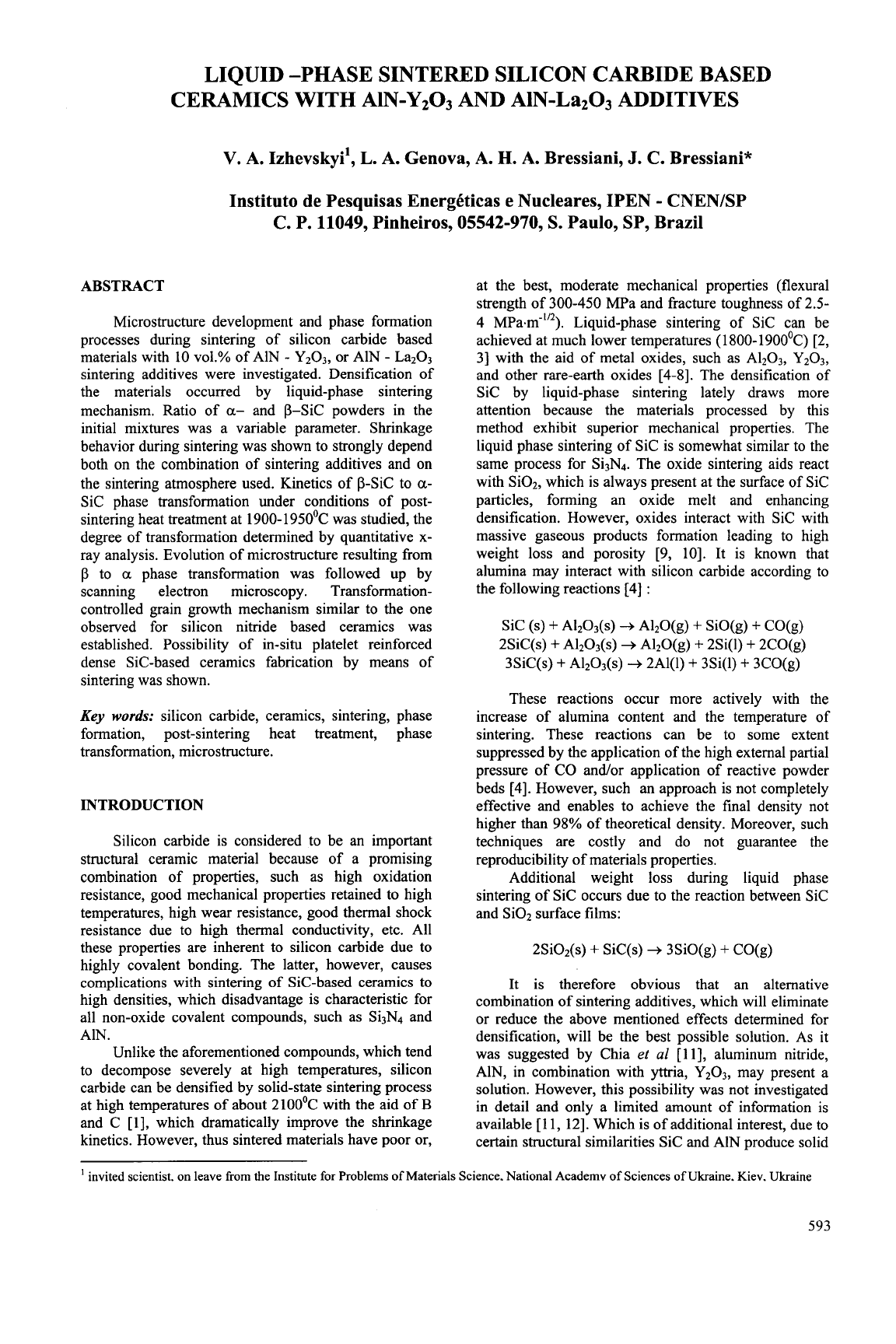
LIQUID -PHASE SINTERED SILICON CARBIDE BASED
CERAMICS WITH A1N-Y2O3 AND AIN-La203 ADDITIVES
V.
A.
Izhevskyi’,
L.
A.
Genova,
A.
H.
A.
Bressiani,
J.
C. Bressiani”
Instituto de Pesquisas EnergCticas e Nucleares, IPEN
-
CNEN/SP
C. P. 11049, Pinheiros, 05542-970,
S.
Paulo, SP, Brazil
ABSTRACT
Microstructure development and phase formation
processes during sintering of silicon carbide based
materials with
10
vol.% of AlN
-
Y2O3, or AlN
-
La203
sintering additives were investigated. Densification of
the materials occurred by liquid-phase sintering
mechanism. Ratio of
a-
and p-Sic powders in the
initial mixtures was a variable parameter. Shrinkage
behavior during sintering was shown to strongly depend
both on the combination of sintering additives and on
the sintering atmosphere used. Kinetics of p-Sic to
a-
Sic phase transformation under conditions of post-
sintering heat treatment at 190O-195O0C was studied, the
degree of transformation determined by quantitative x-
ray analysis. Evolution of microstructure resulting from
p
to
a
phase transformation was followed up by
scanning electron microscopy. Transformation-
controlled grain growth mechanism similar to the one
observed for silicon nitride based ceramics was
established. Possibility of in-situ platelet reinforced
dense Sic-based ceramics fabrication by means of
sintering was shown.
Key
words:
silicon carbide, ceramics, sintering, phase
formation, post-sintering heat treatment, phase
transformation, microstructure.
INTRODUCTION
Silicon carbide is considered to be an important
structural ceramic material because of a promising
combination of properties, such as high oxidation
resistance, good mechanical properties retained to high
temperatures, high wear resistance, good thermal shock
resistance due to high thermal conductivity, etc. All
these properties are inherent to silicon carbide due to
highly covalent bonding. The latter, however, causes
complications with sintering of Sic-based ceramics to
high densities, which disadvantage is characteristic for
all non-oxide covalent compounds, such as Si3N4 and
AlN.
Unlike the aforementioned compounds, which tend
to decompose severely at high temperatures, silicon
carbide can be densified by solid-state sintering process
at high temperatures of about 210OoC with the aid of
B
and C [l], which dramatically improve the shrinkage
kinetics. However, thus sintered materials have poor or,
at the best, moderate mechanical properties (flexural
strength
of
300-450 MPa and fracture toughness of 2.5-
4 MPaem-’”). Liquid-phase sintering of Sic can be
achieved at much lower temperatures
(
1800-19OO0C) [2,
31 with the aid of metal oxides, such as A1203, Y2O3,
and other rare-earth oxides [4-81. The densification of
Sic by liquid-phase sintering lately draws more
attention because the materials processed by this
method exhibit superior mechanical properties. The
liquid phase sintering of Sic is somewhat similar to the
same process for Si3N4. The oxide sintering aids react
with Si02, which is always present at the surface
of
Sic
particles, forming an oxide melt and enhancing
densification. However, oxides interact with Sic with
massive gaseous products formation leading to high
weight loss and porosity [9, 101. It is known that
alumina may interact with silicon carbide according to
the following reactions [4]
:
Sic
(s)
+
A1203(s)
-+
A120(g)
+
SiO(g)
+
cO(g)
2SiC(s)
+
A1203(s)
-+
Al2O(g)
+
2Si(l)
+
2CO(g)
3SiC(s)
+
A1203(s)
+
2Al(l)
+
3Si(l)
+
3CO(g)
These reactions occur more actively with the
increase of alumina content and the temperature
of
sintering. These reactions can be to some extent
suppressed by the application
of
the high external partial
pressure of CO and/or application of reactive powder
beds [4]. However, such an approach is not completely
effective and enables to achieve the final density not
higher than 98% of theoretical density. Moreover, such
techniques are costly and do not guarantee the
reproducibility of materials properties.
Additional weight loss during liquid phase
sintering of Sic occurs due to the reaction between Sic
and Si02 surface films:
2SiOZ(s)
+
SiC(s)
+
3SiO(g)
+
CO(g)
It is therefore obvious that an alternative
combination of sintering additives, which will eliminate
or reduce the above mentioned effects determined for
densification, will be the best possible solution.
As
it
was suggested by Chia
et
a1
[
113, aluminum nitride,
AlN, in combination with yttria, Y2O3, may present a
solution. However, this possibility was not investigated
in detail and only a limited amount of information is
available [ll, 121. Which is of additional interest, due to
certain structural similarities Sic and AIN produce solid
I
invited scientist.
on
leave from the Institute
for
Problems of Materials Science. National Academv
of
Sciences
of
Ukraine. Kiev. Ukraine
593
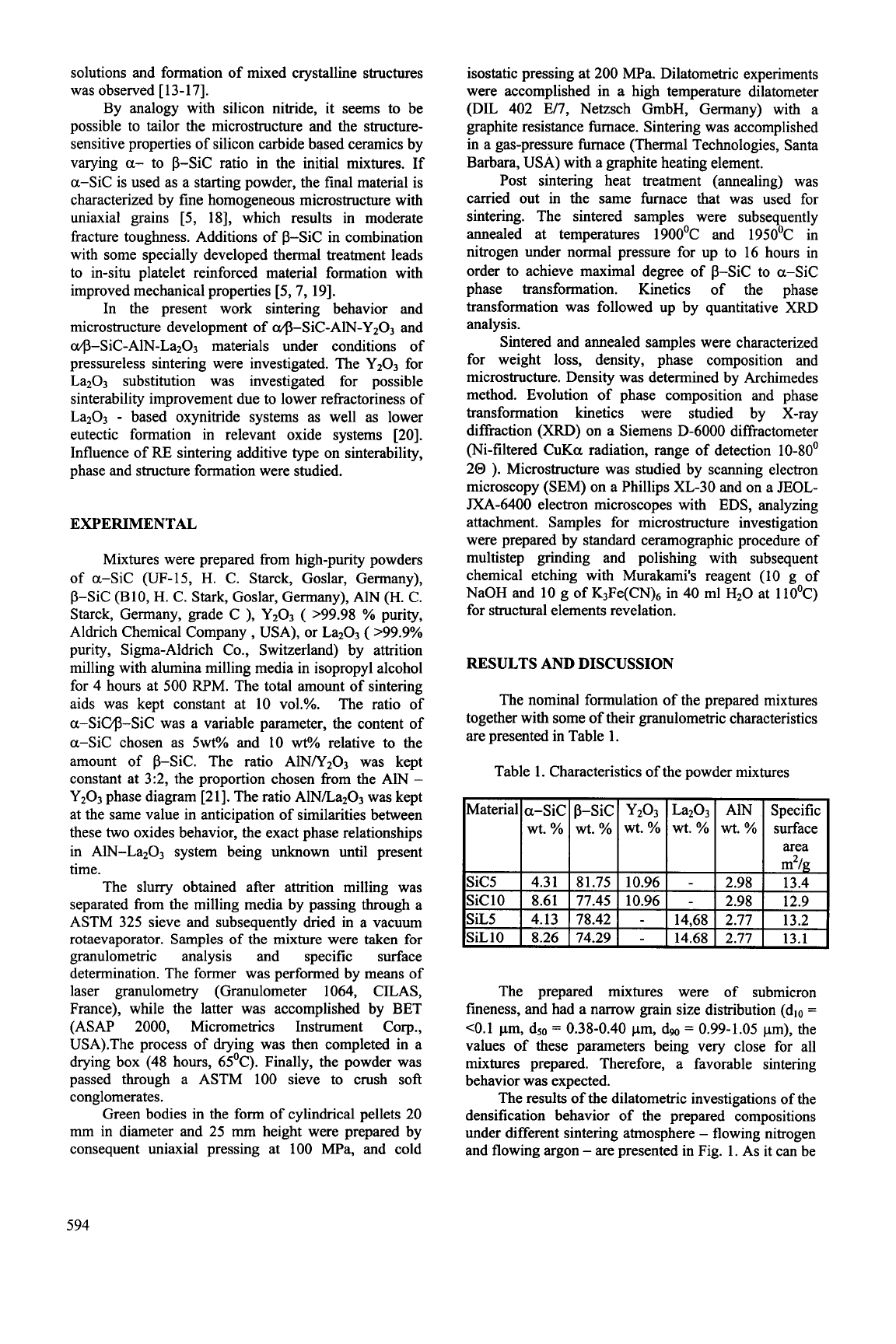
solutions and formation of mixed crystalline structures
was observed [13-171.
By analogy with silicon nitride, it seems to be
possible to tailor the microstructure and the structure-
sensitive properties of silicon carbide based ceramics by
varying
a-
to p-Sic ratio in the initial mixtures. If
a-Sic is used as a starting powder, the final material is
characterized by fine homogeneous microstructure with
uniaxial grains
[5,
181, which results in moderate
fracture toughness. Additions of p-Sic in combination
with some specially developed thermal treatment leads
to in-situ platelet reinforced material formation with
improved mechanical properties
[5,7,
191.
In the present work sintering behavior and
microstructure development of @-SiC-A1N-Y2O3 and
@-SiC-A1N-La203 materials under conditions of
pressureless sintering were investigated. The Y2O3 for
La203 substitution was investigated for possible
sinterability improvement due to lower refractoriness of
La203
-
based oxynitride systems as well as lower
eutectic formation in relevant oxide systems [20].
Influence of
RE
sintering additive type on sinterability,
phase and structure formation were studied.
Material
EXPERIMENTAL
a-SiC P-Sic
Y2O3
La203 AlN
Specific
wt.% wt.%
wt.%
wt.%
wt.%
surface
area
Mixtures were prepared from high-purity powders
of a-Sic (UF-15,
H.
C. Starck, Goslar, Germany),
p-Sic (B10,
H.
C. Stark, Goslar, Germany), AlN
(H.
C.
Starck, Germany, grade C
),
Y203
(
>99.98
%
purity,
Aldrich Chemical Company
,
USA), or La203
(
>99.9%
purity, Sigma-Aldrich Co., Switzerland) by attrition
milling with alumina milling media in isopropyl alcohol
for
4
hours at
500
RPM.
The total amount of sintering
aids was kept constant at 10 vol.%. The ratio of
a-SiW-SiC was a variable parameter, the content of
a-Sic chosen as 5wt% and 10
wF!!
relative to the
amount of p-Sic. The ratio AlN/Y203 was kept
constant at 312, the proportion chosen from the AlN
-
Y2O3 phase diagram [21]. The ratio A1N/La203 was kept
at the same value in anticipation of similarities between
these
two
oxides behavior, the exact phase relationships
in A1N-La2O3 system being
unknown
until present
time.
The slurry obtained after attrition milling was
separated from the milling media by passing through a
ASTM 325 sieve and subsequently dried in a vacuum
rotaevaporator. Samples of the mixture were taken for
granulometric analysis and specific surface
determination. The former was performed by means of
laser granulometry (Granulometer 1064, CILAS,
France), while the latter was accomplished by BET
(ASAP 2000, Micrometrics Instrument Corp.,
USA).The process of drying was then completed in a
drying box (48 hours, 65'C). Finally, the powder was
passed through a ASTM 100 sieve to crush soft
conglomerates.
Green bodies in the form of cylindrical pellets
20
mm in diameter and
25
mm
height were prepared by
consequent uniaxial pressing at 100 MPa, and cold
isostatic pressing at 200 ma. Dilatometric experiments
were accomplished in a high temperature dilatometer
(DIL 402 E/7, Netzsch GmbH, Germany) with a
graphite resistance furnace. Sintering was accomplished
in a gas-pressure furnace (Thermal Technologies, Santa
Barbara, USA) with a graphite heating element.
Post sintering heat treatment (annealing) was
carried out in the same furnace that was used for
sintering. The sintered samples were subsequently
annealed at temperatures 1900'C and 195OOC in
nitrogen under normal pressure for up to 16 hours in
order to achieve maximal degree of p-Sic to a-Sic
phase transformation. Kinetics of the phase
transformation was followed up by quantitative
XRD
analysis.
Sintered and annealed samples were characterized
for weight loss, density, phase composition and
microstructure. Density was determined by Archimedes
method. Evolution of phase composition and phase
transformation kinetics were studied by X-ray
diffraction
(XRD)
on a Siemens D-6000 diffractometer
(Ni-filtered CuKa radiation, range
of
detection 10-80'
20
).
Microstructure was studied by scanning electron
microscopy (SEM) on a Phillips XL-30 and on a JEOL-
JXA-6400 electron microscopes with EDS, analyzing
attachment. Samples for microstructure investigation
were prepared by standard ceramographic procedure of
multistep grinding and polishing with subsequent
chemical etching with Murakami's reagent (10 g of
NaOH and
10
g of K3Fe(CN)6 in
40
ml
H20
at 1 10°C)
for structural elements revelation.
RESULTS
AND
DISCUSSION
The nominal formulation of the prepared mixtures
together with some of their granulometric characteristics
are presented in Table 1.
Table 1. Characteristics of the powder mixtures
The prepared mixtures were of submicron
fineness, and had a narrow grain size distribution (dlo
=
<0.1 pm, dso
=
0.38-0.40
pm, dw
=
0.99-1.05 pm), the
values of these parameters being very close for all
mixtures prepared. Therefore, a favorable sintering
behavior was expected.
The results
of
the dilatometric investigations of the
densification behavior of the prepared compositions
under different sintering atmosphere
-
flowing nitrogen
and flowing argon
-
are presented in Fig. 1. As it can be
5
94

seen, the behavior of Sic and SiL groups of
compositions is strikingly different both in terms of
linear shrinkage and shrinkage rate depending on the
sintering atmosphere. The influence of the a-Sic
content in the initial mixture has only a slight effect on
the overall shrinkage behavior causing a minor
diminishing in shrinkage rate. However, if the Y2O3 is
substituted for LazO3, the shrinkage behavior changes
dramatically. The linear shrinkage in this case is rather
low in Ar atmosphere(Fig. 1. (a)), and substantially
higher in N2 (Fig. 1. (b)), compared with the one
exhibited by Y2O3 doped mixtures, thus making the
sintering behavior in regard of the atmosphere of
sintering of these
two
groups of compositions inverse. It
must be also noted that in
Ar
atmosphere the beginning
of shrinkage for La203 doped mixtures is shifted about a
100°C towards higher temperatures, while in N2 by
atmosphere shrinkage for both groups of mixtures starts
at about the same temperature of 160OOC.
Even more differences have been observed with
regard of shrinkage rate (Fig. 1. (c) and (d)) of the
studied compositions. If while sintering in
Ar
the
difference in shrinkage rate basically is limited to the
0.0002
-
0.0000
-
4.0002
-
6
0.0004:
2
0.WO6-
0
=
0.MM8-
0.0010
-
0.0012
-
0.02
-
0.00
-
4.02
-
4.04
-
4.06
-
s
4.08-
2
4.10:
If
4.18
ma
800
1m
1200 1400 1600 1800
zoo0
Temperature
("C)
value of the rate for La203 doped compositions being
sufficiently lower, and the maximum being shifted by
2OO0C towards higher temperatures, the sintering in N2
provides a much more complicated picture. It can be
seen that the materials doped with La203 exhibit four
peaks on the shrinkage rate curves, while the Y2O3
doped ones have only
two.
Such behavior suggest a
rather complex sequence of phase formation on heating
in the former group of materials because every
minimum on the shrinkage rate curve corresponds to a
crystalline phase formation, which hinders
densification. Only after a temperature higher than the
melting point of this phase is reached the densification
proceeds.
As it was mentioned before, the exact phase
relationships in the AIN-La203 are not known, and the
molar ratio of the components was kept identical to the
one in the case of AlN-Y203 system in anticipation of
close similarity of the phase relationships in both
systems. However, it is now obvious that in the case of
La203 the phase relations are rather different, and in
order to optimize both composition of the additives and
0.01
-
0.00
-
4.01
-
0.02
-
4.03
-
3
4.01-
0
0.05
-
4.06
-
4.07
-
4
.
8w
8w
1000 1200 1400
1600
1800
2WO
Temperature
("C)
d,.,.,.,.,.,.,.,,
600
800
low
12w 1400
18w
18W
Mw
Temperature
("C)
o'oool
1
0.0000
-
-0.0001
-
I-
5
-o.ooo2
:
3
'0
0.0003-
P
0.0004
-0.0005
-x-Sic10
-
N
600
800
1000
1200
1400
1600
1800 2000
Temperature
("C)
Fig. 1. Dilatometric measurements: (a) and
(b)
-
linear shrinkage in Ar and Nz, respectively;
(c) and (d)
-
shrinkage rate in Ar and N2, respectively.
595
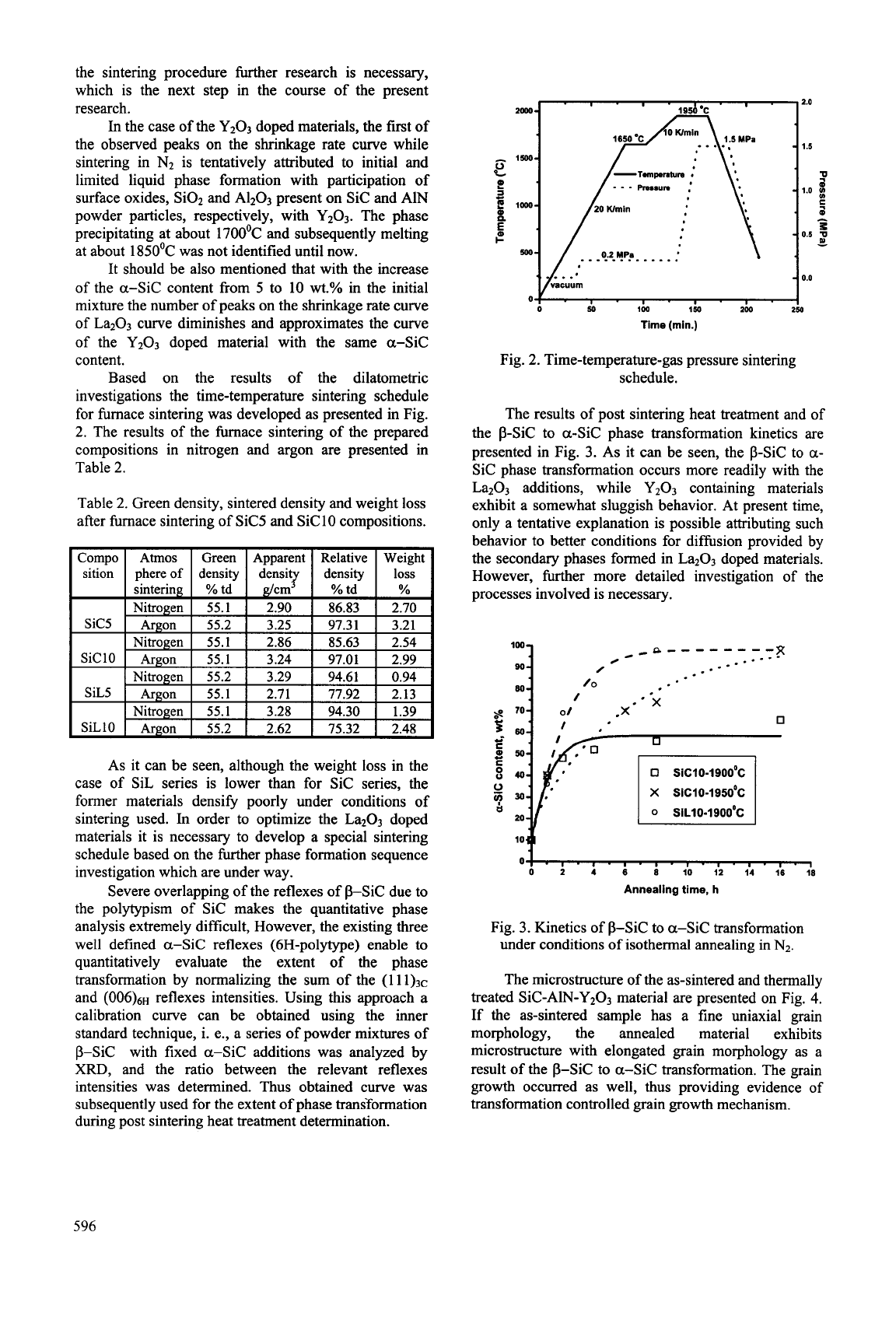
the sintering procedure further research is necessary,
which is the next step in the course of the present
research.
In the case of the Y2O3 doped materials, the first of
the observed peaks on the shrinkage rate curve while
sintering in N2 is tentatively attributed to initial and
limited liquid phase formation with participation of
surface oxides, Si02 and A1203 present on Sic and AlN
powder particles, respectively, with Y2O3. The phase
precipitating at about 1 7OO0C and subsequently melting
at about 1 85OoC was not identified until now.
It should be also mentioned that with the increase
of the a-Sic content from
5
to 10
wt.%
in the initial
mixture the number of peaks on the shrinkage rate curve
of La203 curve diminishes and approximates the curve
of the Y203 doped material with the same a-Sic
content.
Based on the results of the dilatometric
investigations the time-temperature sintering schedule
for furnace sintering was developed as presented in Fig.
2.
The results of the furnace sintering of the prepared
compositions in nitrogen and argon are presented in
Table
2.
Table
2.
Green density, sintered density and weight loss
after furnace sintering of Sic5 and Sic10 compositions.
As it can be seen, although the weight
loss
in the
case of SiL series is lower than for Sic series, the
former materials densify poorly under conditions of
sintering used. In order to optimize the La203 doped
materials it is necessary to develop a special sintering
schedule based on the further phase formation sequence
investigation which are under way.
Severe overlapping of the reflexes of p-Sic due to
the polytypism of SIC makes the quantitative phase
analysis extremely difficult, However, the existing three
well defined a-Sic reflexes (6H-polytype) enable to
quantitatively evaluate the extent of the phase
transformation by normalizing the sum of the (1 1 l)3c
and
(006)6H
reflexes intensities. Using this approach a
calibration curve can be obtained using the inner
standard technique, i. e., a series of powder mixtures of
p-Sic with fixed a-Sic additions was analyzed by
XRD,
and the ratio between the relevant reflexes
intensities was determined. Thus obtained curve was
subsequently used for the extent of phase transformation
during post sintering heat treatment determination.
2.0
2ooo- .
ISSd'C
.
'
.
-
1.5
1500-
e
t
-
1.0
M
.$
f
two-
5
-
z
P
c
-
0.5
'II
-
500-
of.,
. ,
.
,
. , .
I
0
50
1W
150
ZW
250
Time (min.)
Fig.
2.
Time-temperature-gas pressure sintering
schedule.
The results of post sintering heat treatment and of
the p-Sic to a-Sic phase transformation kinetics are
presented in Fig.
3.
As it can be seen, the p-Sic to
a-
Sic phase transformation occurs more readily with the
La203 additions, while Y2O3 containing materials
exhibit a somewhat sluggish behavior. At present time,
only a tentative explanation is possible attributing such
behavior to better conditions for diffusion provided by
the secondary phases formed in La203 doped materials.
However, firher more detailed investigation of the
processes involved is necessary.
im
#-a------
:-
-r
?
0
...-
0
_..
lo!------
0
0
2
4
6
8
10 12 14 16 18
Annealing time,
h
Fig.
3.
Kinetics of p-Sic to a-Sic transformation
under conditions
of
isothermal annealing in
NZ.
The microstructure of the as-sintered and thermally
treated SiC-AlN-Y203 material are presented on Fig.
4.
If the as-sintered sample has a fine uniaxial grain
morphology, the annealed material exhibits
microstructure with elongated grain morphology as a
result of the p-Sic to a-Sic transformation. The grain
growth occurred as well, thus providing evidence of
transformation controlled grain growth mechanism.
596
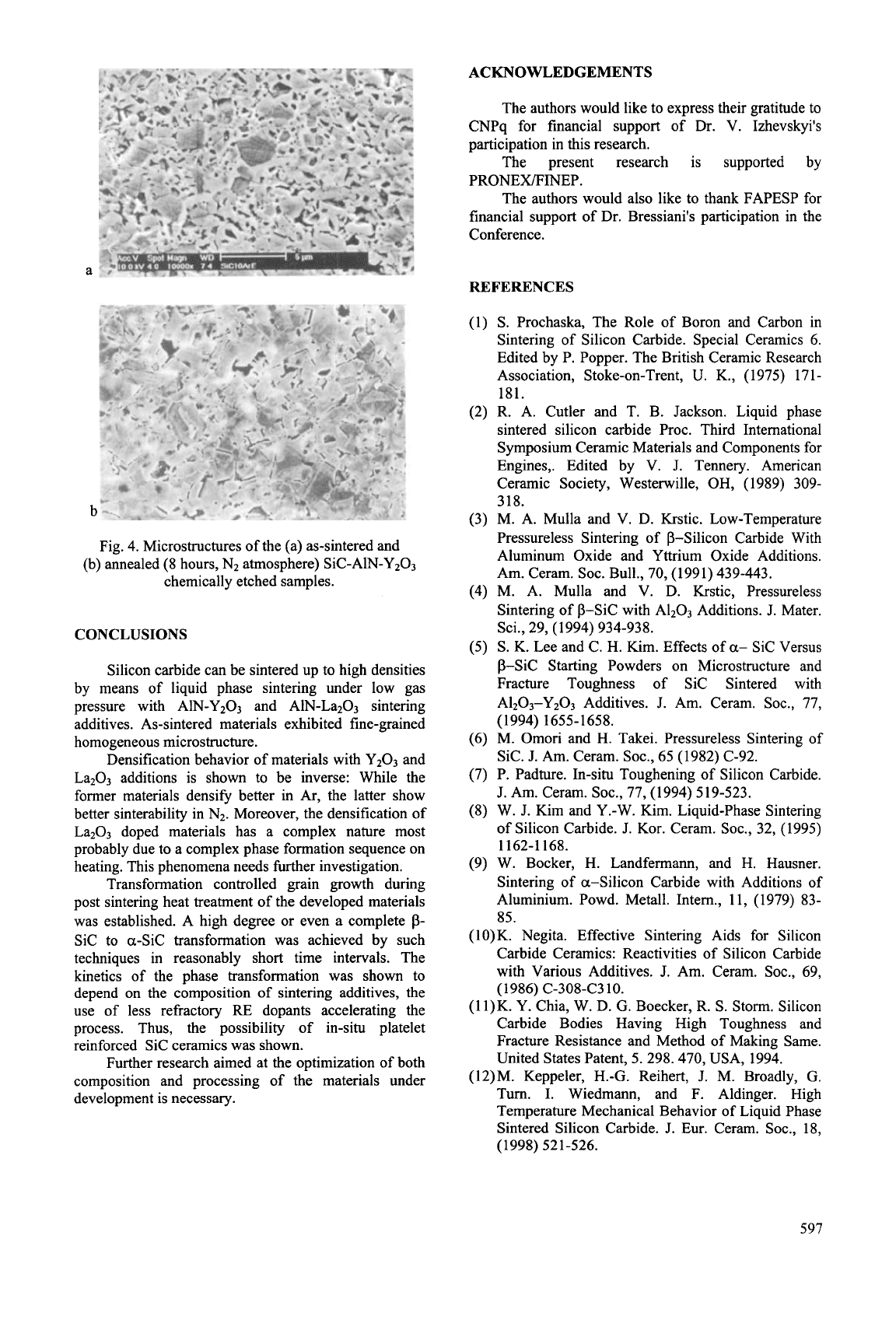
ACKNOWLEDGEMENTS
Fig. 4. Microstructures of the (a) as-sintered and
(b) annealed (8 hours, N2 atmosphere) SiC-A1N-Y203
chemically etched samples.
CONCLUSIONS
Silicon carbide can be sintered up to high densities
by means of liquid phase sintering under low gas
pressure with AlN-Yz03 and AlN-LazO3 sintering
additives. As-sintered materials exhibited fine-grained
homogeneous microstructure.
Densification behavior of materials with Y2O3 and
La203 additions is shown to be inverse: While the
former materials densify better in Ar, the latter show
better sinterability in
NZ.
Moreover, the densification of
La203 doped materials has a complex nature most
probably due to a complex phase formation sequence on
heating. This phenomena needs further investigation.
Transformation controlled grain growth during
post sintering heat treatment of the developed materials
was established. A high degree or even a complete
p-
Sic
to
a-Sic transformation was achieved by such
techniques in reasonably short time intervals. The
kinetics of the phase transformation was shown to
depend on the composition
of
sintering additives, the
use of less refractory
RE dopants accelerating the
process. Thus, the possibility of in-situ platelet
reinforced Sic ceramics was shown.
Further research aimed at the optimization of both
composition and processing of the materials under
development is necessary.
The authors would like to express their gratitude to
CNPq for financial support of Dr. V. Izhevskyi's
participation in this research.
The present research is supported by
PRONEWINEP.
The authors would also like to thank FAPESP for
financial support of Dr. Bressiani's participation in the
Conference.
REFERENCES
(1)
S.
Prochaska, The Role of Boron and Carbon in
Sintering of Silicon Carbide. Special Ceramics 6.
Edited by P. Popper. The British Ceramic Research
Association, Stoke-on-Trent,
U.
K., (1975) 171-
181.
(2) R. A. Cutler and T.
B. Jackson. Liquid phase
sintered silicon carbide Proc. Third International
Symposium Ceramic Materials and Components for
Engines,. Edited by V. J. Tennery. American
Ceramic Society, Westerwille, OH, (1989) 309-
318.
(3) M. A. Mulla and V. D. Krstic. Low-Temperature
Pressureless Sintering of p-Silicon Carbide With
Aluminum Oxide and Yttrium Oxide Additions.
Am. Ceram. SOC. Bull., 70, (1991) 439-443.
(4) M. A. Mulla and V. D. Krstic, Pressureless
Sintering of p-Sic with A1203 Additions. J. Mater.
Sci., 29, (1994) 934-938.
(5)
S.
K. Lee and C.
H.
Kim. Effects of
a-
Sic Versus
p-Sic Starting Powders on Microstructure and
Fracture Toughness of Sic Sintered with
A1203-Y203 Additives. J. Am. Ceram. SOC., 77,
(6) M. Omori and
H.
Takei. Pressureless Sintering of
Sic.
J.
Am. Ceram. SOC., 65 (1982) C-92.
(7) P. Padture. In-situ Toughening of Silicon Carbide.
J.
Am.
Ceram. SOC., 77, (1 994) 5 19-523.
(8)
W.
J.
Kim and Y.-W. Kim. Liquid-Phase Sintering
of Silicon Carbide.
J.
Kor. Ceram. SOC., 32, (1995)
(9)
W.
Bocker,
H.
Landfermann, and H. Hausner.
Sintering of a-Silicon Carbide with Additions of
Aluminium. Powd. Metall. Intern., 11, (1979) 83-
85.
(10)K. Negita. Effective Sintering Aids for Silicon
Carbide Ceramics: Reactivities of Silicon Carbide
with Various Additives. J. Am. Ceram. SOC., 69,
(11)K. Y. Chia, W. D. G. Boecker, R.
S.
Storm. Silicon
Carbide Bodies Having High Toughness and
Fracture Resistance and Method of Making Same.
United States Patent,
5.
298.470, USA, 1994.
(12)M. Keppeler, H.-G. Reihert, J. M. Broadly, G.
Turn. I. Wiedmann, and F. Aldinger. High
Temperature Mechanical Behavior of Liquid Phase
Sintered Silicon Carbide.
J.
Eur. Ceram. SOC., 18,
(1994) 1655-1658.
1162-1 168.
(1986) C-308-C3
10.
(1998) 521-526.
597
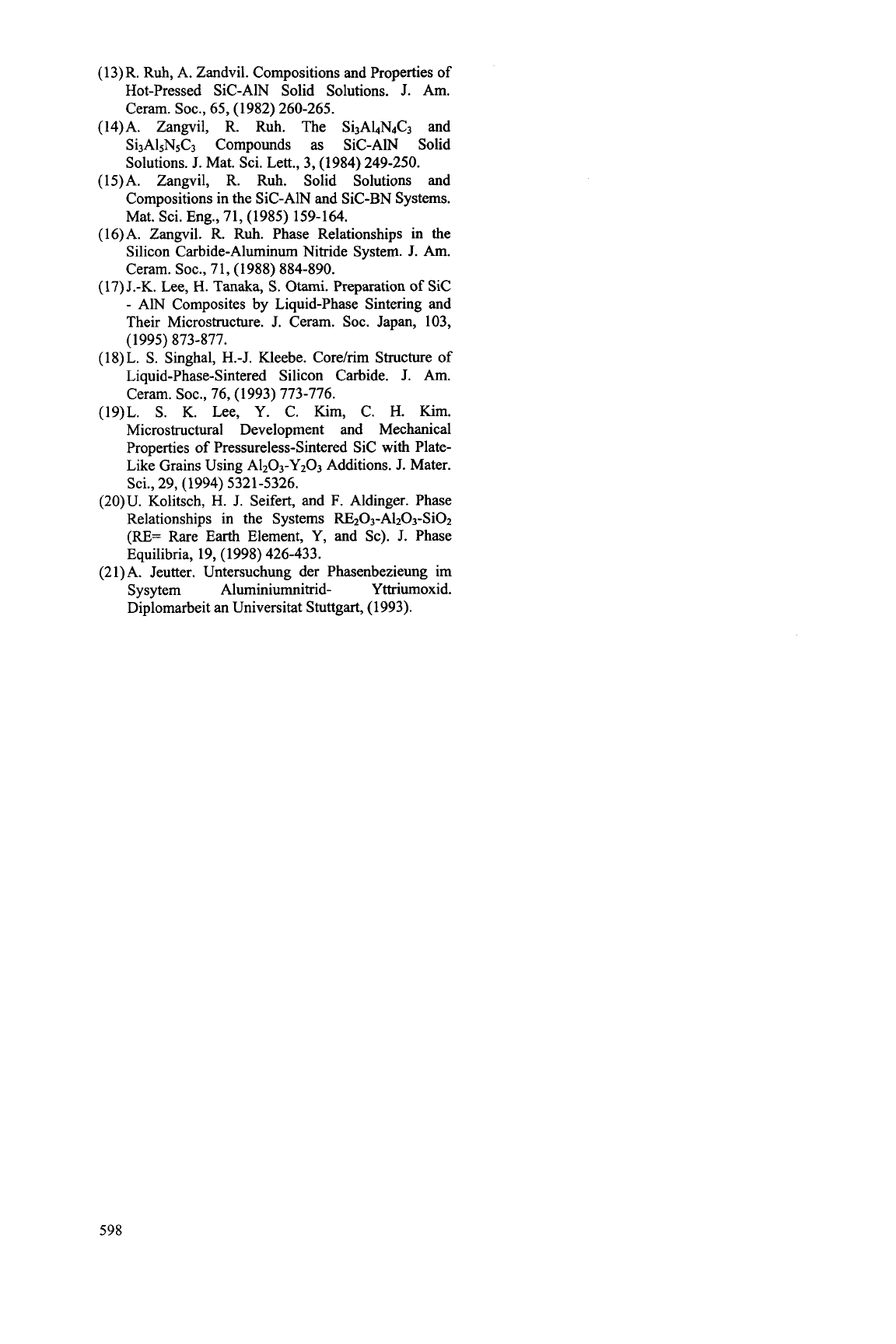
(1 3) R. Ruh, A. Zandvil. Compositions and Properties of
Hot-Pressed Sic-AlN Solid Solutions. J.
Am.
Ceram. SOC., 65, (1982) 260-265.
(14)A. Zangvil, R. Ruh. The Si3A&N4C3 and
Si3AI5N5C3 Compounds
as
SIC-AlN Solid
Solutions. J. Mat. Sci. Lett., 3, (1984) 249-250.
(15)A. Zangvil, R. Ruh. Solid Solutions and
Compositions in the Sic-AlN and SIC-BN Systems.
Mat. Sci. Eng., 71, (1985) 159-164.
(16)A. Zangvil. R. Ruh. Phase Relationships
in
the
Silicon Carbide-Aluminum Nitride System.
J.
Am.
Ceram. SOC., 71, (1988) 884-890.
(17)J.-K. Lee,
H.
Tanaka,
S.
Otami.
Preparation of Sic
-
AlN Composites by Liquid-Phase Sintering and
Their Microstructure. J. Ceram.
SOC.
Japan, 103,
(18)L.
S.
Singhal, H.-J. Kleebe. Corehim Structure of
Liquid-Phase-Sintered Silicon Carbide. J. Am.
Ceram. SOC., 76, (1993) 773-776.
(19)L.
S.
K.
Lee, Y. C. Kim, C. H. Kim.
Microstructural Development and Mechanical
Properties of Pressureless-Sintered Sic with Plate-
Like Grains Using A1203-Y203 Additions. J. Mater.
Sci., 29, (1994) 5321-5326.
(20)U. Kolitsch,
H.
J. Seifert, and
F.
Aldinger. Phase
Relationships in the Systems RE203-A1203-Si02
(RE=
Rare Earth Element, Y, and Sc). J. Phase
Equilibria, 19, (1998) 426-433.
(2
1)
A. Jeutter. Untersuchung der Phasenbezieung im
Sysytem Aluminiumnitrid- Yttriumoxid.
Diplomarbeit an Universitat Stuttgart, (1993).
(1995) 873-877.
598
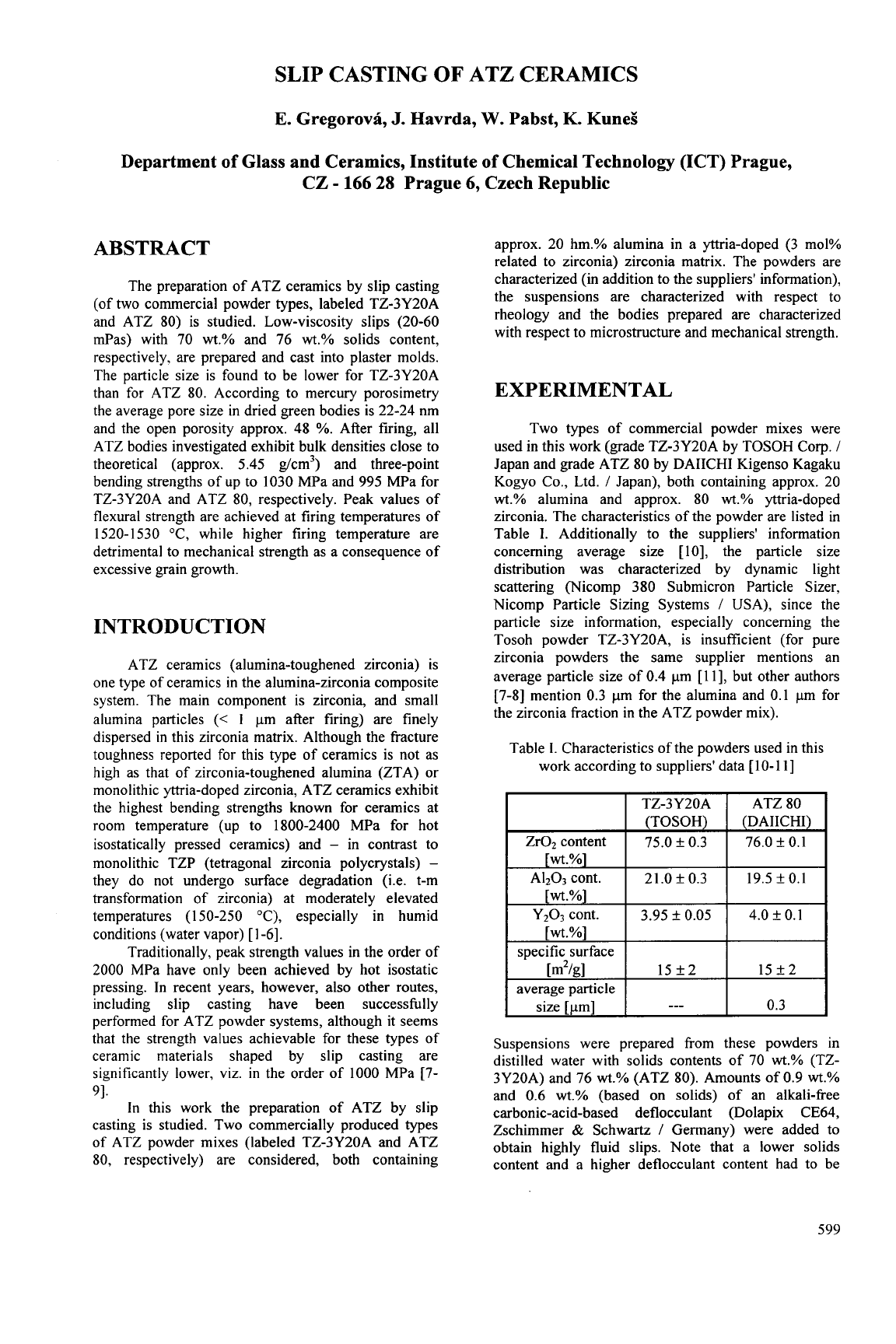
SLIP CASTING
OF
ATZ CERAMICS
Zr02 content
A1203 cont.
Y2O3 cont.
specific surface
rm2/gl
[wt.YO]
[wt.YO]
[wt.%]
E.
Gregorova,
J.
Havrda,
W.
Pabst, K. Kunei
TZ-3 Y20A ATZ 80
(TOSOH) (DAIICHI)
75.0
f
0.3 76.0
k
0.1
21.0
k
0.3 19.5
k
0.1
3.95
k
0.05 4.0
k
0.1
15+2
15+2
Department
of
Glass and Ceramics, Institute
of
Chemical Technology (ICT) Prague,
CZ
-
166
28
Prague
6,
Czech Republic
average particle
size [pm]
ABSTRACT
---
0.3
The preparation of ATZ ceramics by slip casting
(of two commercial powder types, labeled TZ-3Y20A
and ATZ 80) is studied. Low-viscosity slips (20-60
mPas) with 70
wt.%
and 76
wt.%
solids content,
respectively, are prepared and cast into plaster molds.
The particle size is found to be lower for TZ-3Y20A
than for ATZ 80. According to mercury porosimetry
the average pore size in dried green bodies
is
22-24 nm
and the open porosity approx. 48
%.
After firing, all
ATZ bodies investigated exhibit bulk densities close to
theoretical (approx. 5.45 g/cm3) and three-point
bending strengths of up to 1030 MPa and 995 MPa for
TZ-3Y20A and ATZ 80, respectively. Peak values of
flexural strength are achieved at firing temperatures of
1520-1530 "C, while higher firing temperature are
detrimental to mechanical strength as a consequence
of
excessive grain growth.
INTRODUCTION
ATZ ceramics (alumina-toughened zirconia) is
one type of ceramics in the alumina-zirconia composite
system. The main component
is
zirconia, and small
alumina particles
(<
1
pm after firing) are finely
dispersed in this zirconia matrix. Although the fracture
toughness reported for this type of ceramics
is
not as
high as that of zirconia-toughened alumina (ZTA) or
monolithic yttria-doped zirconia, ATZ ceramics exhibit
the highest bending strengths known for ceramics at
room temperature (up to 1800-2400 MPa for hot
isostatically pressed ceramics) and
-
in contrast to
monolithic TZP (tetragonal zirconia polycrystals)
-
they do not undergo surface degradation (i.e. t-m
transformation of zirconia) at moderately elevated
temperatures (1 50-250
"C),
especially in humid
conditions (water vapor)
[
1-61.
Traditionally, peak strength values in the order of
2000 MPa have only been achieved by hot isostatic
pressing.
In
recent years, however, also other routes,
including slip casting have been successfully
performed for ATZ powder systems, although it seems
that the strength values achievable for these types of
ceramic materials shaped by slip casting are
significantly lower, viz. in the order of 1000 MPa [7-
In this work the preparation
of
ATZ by slip
casting
is
studied. Two commercially produced types
of ATZ powder mixes (labeled TZ-3Y20A and ATZ
80, respectively) are considered, both containing
91.
approx. 20 hm.% alumina in a yttria-doped (3 mol%
related to zirconia) zirconia matrix. The powders are
characterized (in addition to the suppliers' information),
the suspensions are characterized with respect to
rheology and the bodies prepared are characterized
with respect to microstructure and mechanical strength.
EXPERIMENTAL
Two types of commercial powder mixes were
used in this work (grade TZ-3Y20A by TOSOH Corp.
/
Japan and grade ATZ 80 by DAIICHI Kigenso Kagaku
Kogyo Co., Ltd.
I
Japan), both containing approx. 20
wt.%
alumina and approx. 80
wt.%
yttria-doped
zirconia. The characteristics of the powder are listed in
Table
I.
Additionally to the suppliers' information
concerning average size [lo], the particle size
distribution was characterized by dynamic light
scattering (Nicomp 3 80 Submicron Particle Sizer,
Nicomp Particle Sizing Systems
/
USA), since the
particle size information, especially concerning the
Tosoh powder TZ-3Y20A,
is
insufficient (for pure
zirconia powders the same supplier mentions an
average particle size
of
0.4 pm
[
111, but other authors
[7-81 mention 0.3 pm for the alumina and 0.1 pm for
the zirconia fraction in the ATZ powder mix).
Table
I.
Characteristics of the powders used in this
work according to suppliers' data
[
10-1 11
599
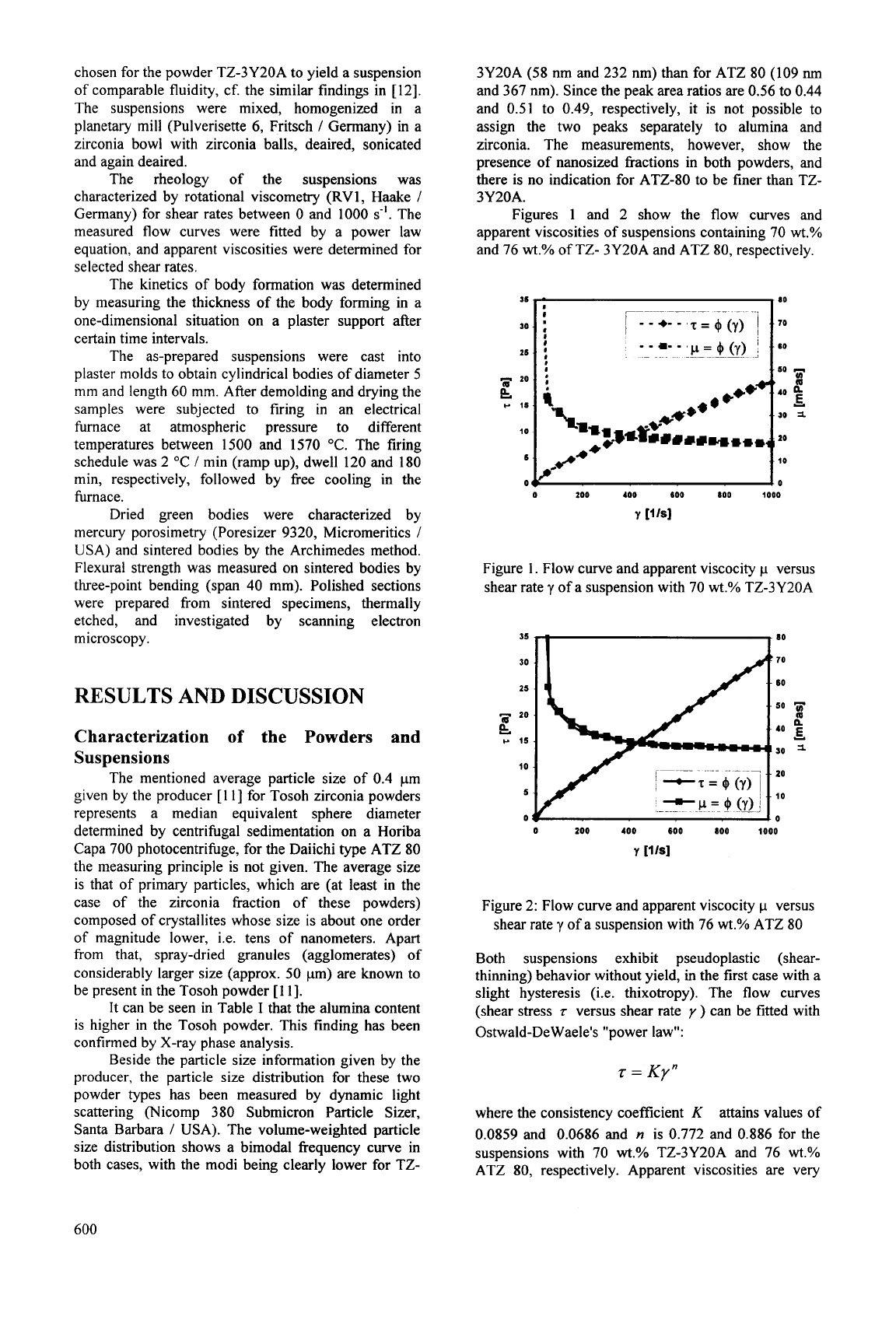
chosen for the powder TZ-3Y20A to yield a suspension
of
comparable fluidity, cf. the similar findings in [12].
The suspensions were mixed, homogenized in a
planetary
mill
(Pulverisette 6, Fritsch
/
Germany) in a
zirconia bowl with zirconia balls, deaired, sonicated
and again deaired.
The rheology of the suspensions was
characterized by rotational viscometry
(RVl,
Haake
/
Germany) for shear rates between
0
and 1000
s-'.
The
measured flow curves were fitted by a power law
equation, and apparent viscosities were determined for
selected shear rates.
The kinetics of body formation was determined
by measuring the thickness of the body forming in a
one-dimensional situation on a plaster support after
certain time intervals.
The as-prepared suspensions were cast into
plaster molds to obtain cylindrical bodies of diameter
5
mm
and length
60
mm.
After demolding and drying the
samples were subjected to firing
in
an electrical
furnace at atmospheric pressure to different
temperatures between 1500 and 1570
"C. The firing
schedule was 2
"C
/
min (ramp up), dwell 120 and 180
min, respectively,
followed by free cooling in the
furnace.
Dried green bodies were characterized by
mercury porosimetry (Poresizer 9320, Micromeritics
/
USA) and sintered bodies by the Archimedes method.
Flexural strength was measured on sintered bodies by
three-point bending (span
40 mm). Polished sections
were prepared from sintered specimens, thermally
etched, and investigated by scanning electron
microscopy.
RESULTS AND
DISCUSSION
Characterization
of
the Powders and
Suspensions
The mentioned average particle size of
0.4
pm
given by the producer
[
1
11
for Tosoh zirconia powders
represents a median equivalent sphere diameter
determined by centrifugal sedimentation on a Horiba
Capa 700 photocentrifuge, for the Daiichi type ATZ 80
the measuring principle is not given. The average size
is that of primary particles, which are (at least in the
case of the zirconia fraction of these powders)
composed of crystallites whose size is about one order
of magnitude lower, i.e. tens
of
nanometers. Apart
from that, spray-dried granules (agglomerates)
of
considerably larger size (approx.
50
pm) are known to
be present in the Tosoh powder
[
1
11.
It can be seen in Table
I
that the alumina content
is higher
in
the Tosoh powder. This finding has been
confirmed by X-ray phase analysis.
Beside the particle size information given by the
producer, the particle size distribution for these two
powder types has been measured by dynamic light
scattering (Nicomp 380 Submicron Particle Sizer,
Santa Barbara
/
USA). The volume-weighted particle
size distribution shows a bimodal frequency curve in
both cases, with the modi being clearly lower for TZ-
3Y20A (58 nm and 232 nm) than for ATZ
80
(109
nm
and 367 nm). Since the peak area ratios are 0.56 to
0.44
and
0.51
to
0.49,
respectively, it is not possible to
assign the two peaks separately to alumina and
zirconia. The measurements, however, show the
presence of nanosized fractions in both powders, and
there is no indication for ATZ-80 to be finer than TZ-
3Y20A.
Figures
1
and
2
show the flow curves and
apparent viscosities of suspensions containing 70 wt.%
and 76
wt.%
of TZ- 3Y20A and ATZ 80, respectively.
36
-
10
0
200
400
600
800
1000
Y
[llsl
Figure
1.
Flow curve and apparent viscocity
p
versus
shear rate
y
of a suspension with 70 wt.% TZ-3Y20A
35
1
-
10
CI
0
n
E
I
I
0
200
400
800 800
1000
Y
[Ilsl
Figure 2: Flow curve and apparent viscocity
p
versus
shear rate
y
of a suspension with 76 wt.% ATZ 80
Both suspensions exhibit pseudoplastic (shear-
thinning) behavior without yield, in the first case with a
slight hysteresis (i.e. thixotropy). The flow curves
(shear stress
r
versus shear rate
y
)
can be fitted with
Ostwald-De Waele's "power law":
r
=
Ky"
where the consistency coefficient
K
attains values of
0.0859 and 0.0686 and
n
is 0.772 and 0.886 for the
suspensions with 70
wt.%
TZ-3Y20A and 76
wt.%
ATZ 80, respectively. Apparent viscosities are very
600
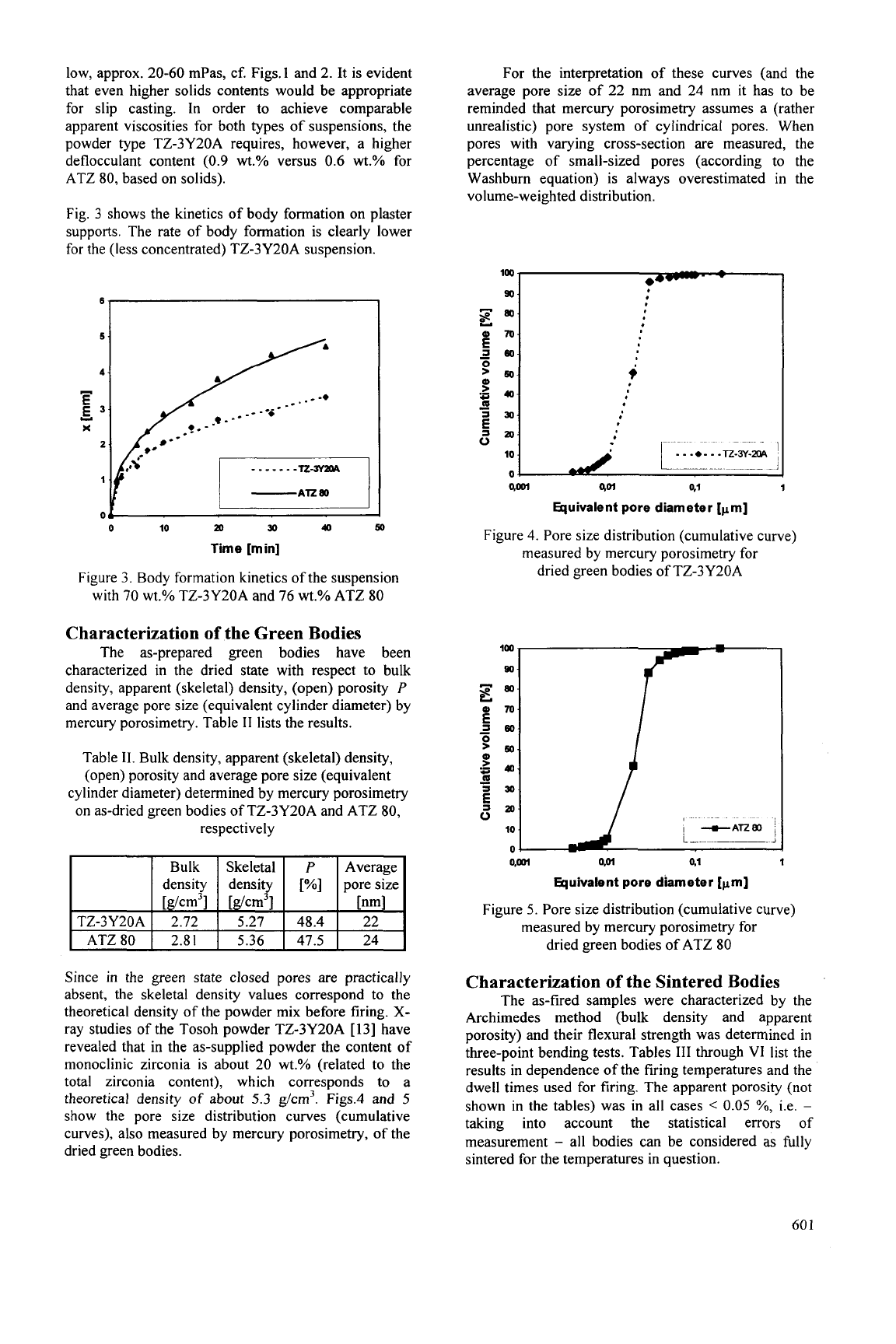
low, approx. 20-60 mPas, cf. Figs.1 and
2.
It is evident
that even higher solids contents would be appropriate
for slip casting. In order to achieve comparable
apparent viscosities for both types of suspensions, the
powder type TZ-3Y20A requires, however, a higher
deflocculant content
(0.9
wt.%
versus 0.6
wt.%
for
ATZ
80,
based on solids).
Bulk
Skeletal
P
Average
density
density
[%I
poresize
1
[nm
For the interpretation of these curves (and the
average pore size of 22 nm and 24 nm it has to be
reminded that mercury porosimetry assumes a (rather
unrealistic) pore system of cylindrical pores. When
pores with varying cross-section are measured, the
percentage of small-sized pores (according to the
Washburn equation) is always overestimated in the
volume-weighted distribution.
Fig. 3 shows the kinetics
of
body formation on plaster
supports. The rate of body formation is clearly lower
for the (less concentrated) TZ-3Y20A suspension.
6
I
0
10
P
m
40
m
Time [min]
Figure
3.
Body formation kinetics of the suspension
with 70 wt.% TZ-3Y20A and 76
wt.%
ATZ
80
Characterization
of
the Green Bodies
The as-prepared green bodies have been
characterized in the dried state with respect to bulk
density, apparent (skeletal) density, (open) porosity
P
and average pore size (equivalent cylinder diameter) by
mercury porosimetry. Table
I1
lists the results.
TZ-3Y20A
I
2.72
I
5.27
I
48.4
I
22
ATZ80
I
2.81
I
5.36
I
47.5
I
24
Since
in
the green state closed pores are practically
absent, the skeletal density values correspond to the
theoretical density of the powder mix before firing.
X-
ray studies
of
the Tosoh powder TZ-3Y20A [13] have
revealed that in the as-supplied powder the content
of
monoclinic zirconia is about
20
wt.%
(related to the
total zirconia content), which corresponds to a
theoretical density
of
about
5.3
g/cm'. Figs.4 and
5
show the pore size distribution curves (cumulative
curves), also measured by mercury porosimetry, of the
dried green bodies.
.
I
t
.
10
I
.
-
.*---Tz-3y-m
'
0
opol
am
1
Quivalent pore diameter [pm]
Figure 4. Pore size distribution (cumulative curve)
measured by mercury porosimetry for
dried green bodies of TZ-3Y20A
O.ooC
am
41
1
Quivalent pore diameter
[pm]
Figure
5.
Pore size distribution (cumulative curve)
measured by mercury porosimetry for
dried green bodies of ATZ
80
Characterization
of
the Sintered Bodies
The as-fired samples were characterized by the
Archimedes method (bulk density and apparent
porosity) and their flexural strength was determined
in
three-point bending tests. Tables
111
through
VI
list the
results in dependence of the firing temperatures and the
dwell times used for firing. The apparent porosity (not
shown in the tables) was in all cases
<
0.05
%,
i.e.
-
taking into account the statistical errors of
measurement
-
all bodies can be considered
as
fully
sintered for the temperatures in question.
60
1
